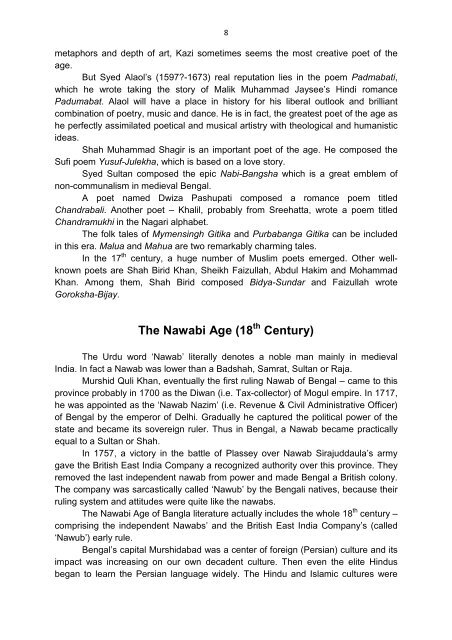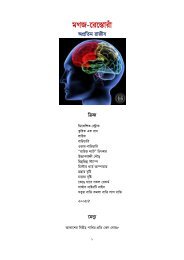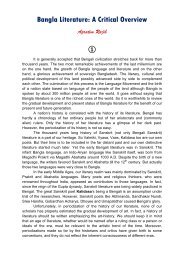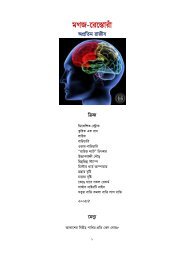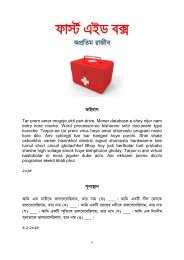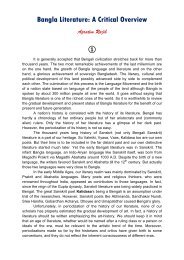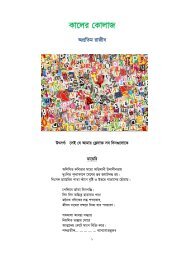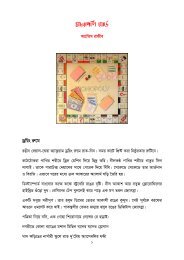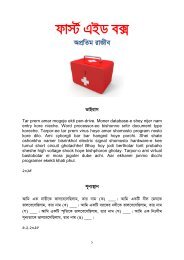BLiterature-Apratim
Create successful ePaper yourself
Turn your PDF publications into a flip-book with our unique Google optimized e-Paper software.
8<br />
metaphors and depth of art, Kazi sometimes seems the most creative poet of the<br />
age.<br />
But Syed Alaol’s (1597?-1673) real reputation lies in the poem Padmabati,<br />
which he wrote taking the story of Malik Muhammad Jaysee’s Hindi romance<br />
Padumabat. Alaol will have a place in history for his liberal outlook and brilliant<br />
combination of poetry, music and dance. He is in fact, the greatest poet of the age as<br />
he perfectly assimilated poetical and musical artistry with theological and humanistic<br />
ideas.<br />
Shah Muhammad Shagir is an important poet of the age. He composed the<br />
Sufi poem Yusuf-Julekha, which is based on a love story.<br />
Syed Sultan composed the epic Nabi-Bangsha which is a great emblem of<br />
non-communalism in medieval Bengal.<br />
A poet named Dwiza Pashupati composed a romance poem titled<br />
Chandrabali. Another poet – Khalil, probably from Sreehatta, wrote a poem titled<br />
Chandramukhi in the Nagari alphabet.<br />
The folk tales of Mymensingh Gitika and Purbabanga Gitika can be included<br />
in this era. Malua and Mahua are two remarkably charming tales.<br />
In the 17 th century, a huge number of Muslim poets emerged. Other wellknown<br />
poets are Shah Birid Khan, Sheikh Faizullah, Abdul Hakim and Mohammad<br />
Khan. Among them, Shah Birid composed Bidya-Sundar and Faizullah wrote<br />
Goroksha-Bijay.<br />
The Nawabi Age (18 th Century)<br />
The Urdu word ‘Nawab’ literally denotes a noble man mainly in medieval<br />
India. In fact a Nawab was lower than a Badshah, Samrat, Sultan or Raja.<br />
Murshid Quli Khan, eventually the first ruling Nawab of Bengal – came to this<br />
province probably in 1700 as the Diwan (i.e. Tax-collector) of Mogul empire. In 1717,<br />
he was appointed as the ‘Nawab Nazim’ (i.e. Revenue & Civil Administrative Officer)<br />
of Bengal by the emperor of Delhi. Gradually he captured the political power of the<br />
state and became its sovereign ruler. Thus in Bengal, a Nawab became practically<br />
equal to a Sultan or Shah.<br />
In 1757, a victory in the battle of Plassey over Nawab Sirajuddaula’s army<br />
gave the British East India Company a recognized authority over this province. They<br />
removed the last independent nawab from power and made Bengal a British colony.<br />
The company was sarcastically called ‘Nawub’ by the Bengali natives, because their<br />
ruling system and attitudes were quite like the nawabs.<br />
The Nawabi Age of Bangla literature actually includes the whole 18 th century –<br />
comprising the independent Nawabs’ and the British East India Company’s (called<br />
‘Nawub’) early rule.<br />
Bengal’s capital Murshidabad was a center of foreign (Persian) culture and its<br />
impact was increasing on our own decadent culture. Then even the elite Hindus<br />
began to learn the Persian language widely. The Hindu and Islamic cultures were


